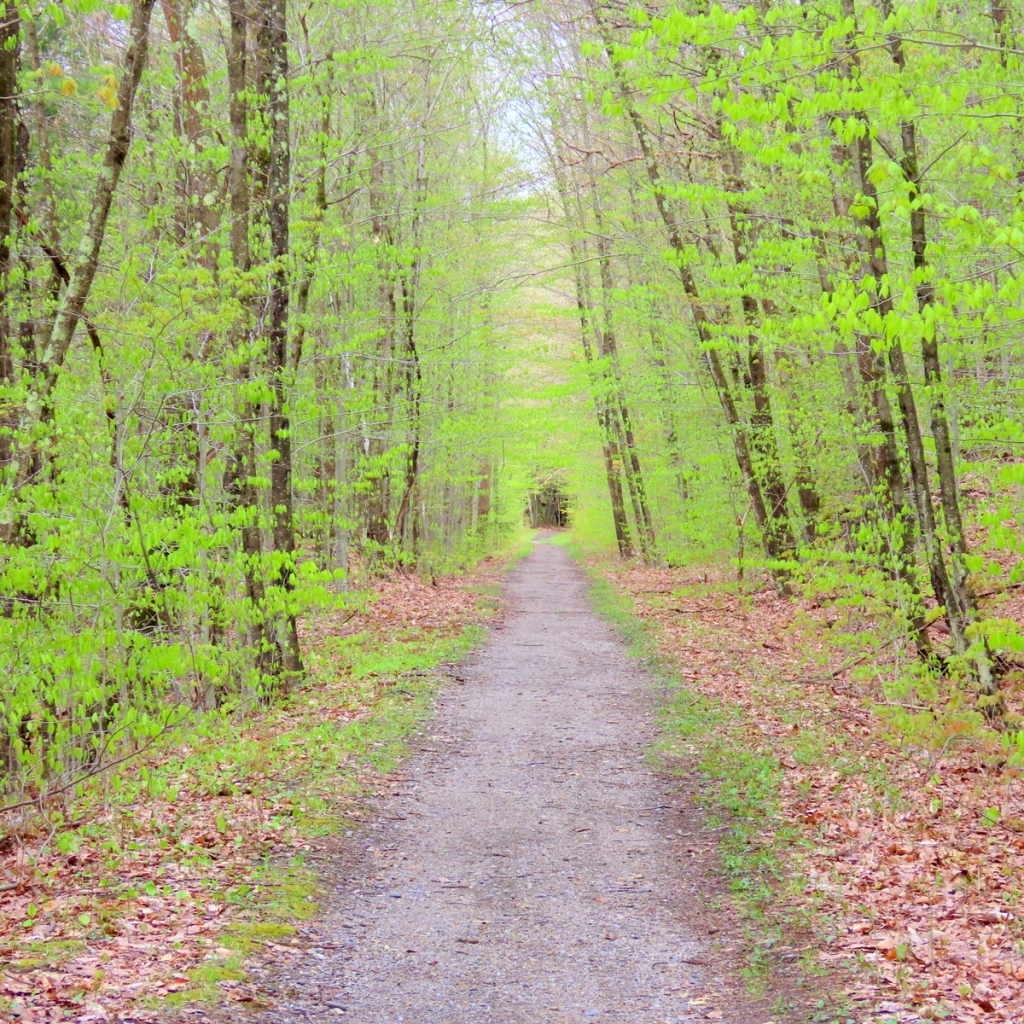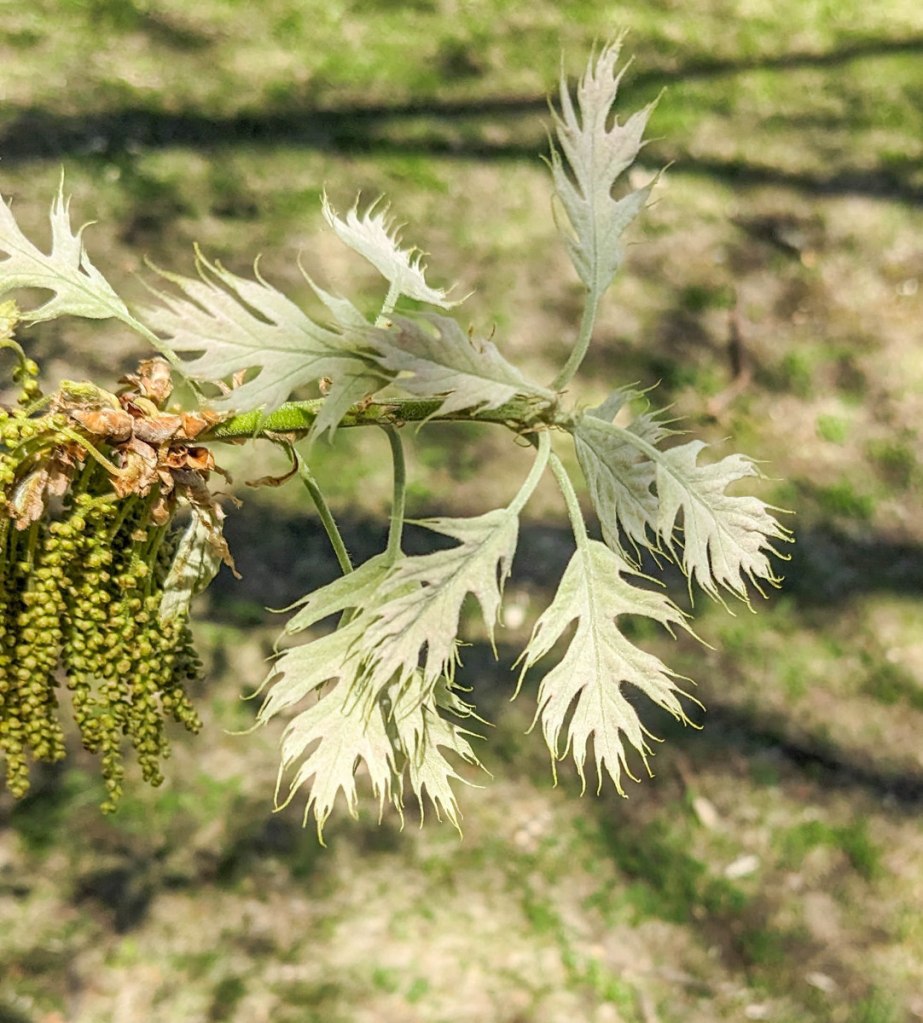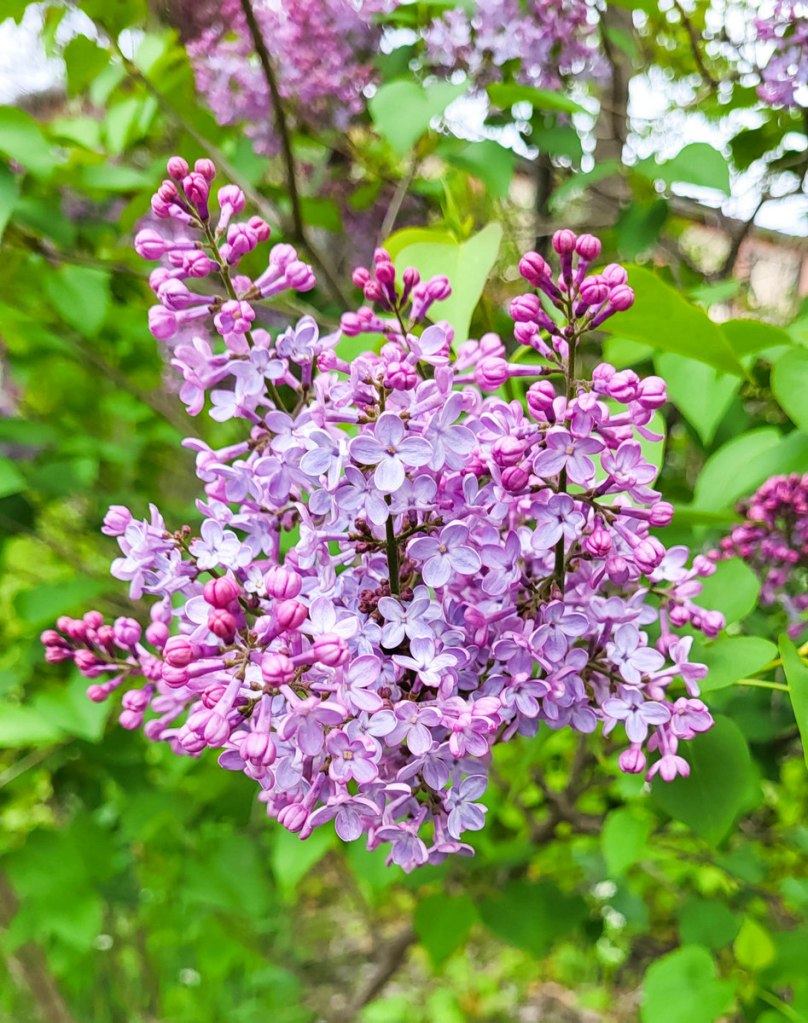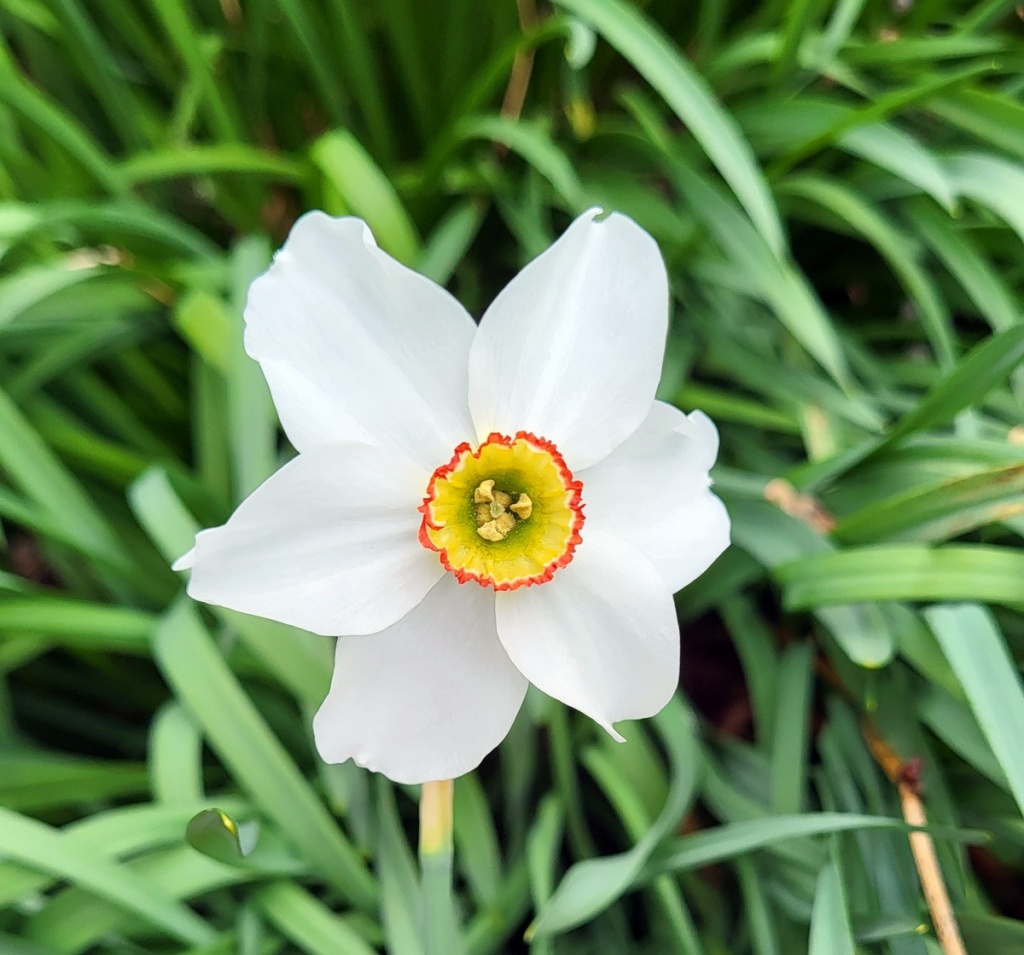
May continues to lean more toward April than June and I think most of us would be surprised to see more than two sunny and warm days in a row. But still the fields are being harrowed and planted and it is warming up. Even on rainy days the temps reach into the 60s F. and that seems to be enough for most plants. Some are a little late but most, like the wild columbine above, have bloomed at their usual time.

I had to walk out to the ledges in Westmoreland three times again this year to see how the columbines and the other rare plants that grow there were doing. This shot shows what the last walk out to the columbines looked like. Virtually every leaf seen here is a beech leaf, just out of the bud. I was reminded that softness is another thing I like about spring.

Blue cohosh is a rare plant that I’ve seen in just one spot, and this is it. Cohosh is a name that Native Americans used for several plants it seems, and the true meaning of the word has been lost. The bluish cast of the stems, flower buds, new spring shoots, and sky blue fruit all point to the blue in its name.

Blue cohosh plants have unusual flowers that are hard to mistake for anything else. What look like yellow-green striped petals are actually the sepals of a blue cohosh flower. Each sepal contains a nectar gland to attract insects. Six yellow stamens form a ring around the center ovary and the true petals are the shiny green parts that ring the center between the sepals and the stamens. The first time I saw this plant I had the feeling that I was seeing something that I might never see again, but fortunately it has come back year after year.

Jack in the pulpit plants were in bloom at the ledges as well. Though they aren’t rare they are unusual enough to make me stop and lift their hoods to see the beautiful stripes on the inside of the spathe and to see how Jack the spadix is doing in the pulpit. These plants are also called bog onions, which hints at the fact that they like water. It’s a good thing because this year they’re getting plenty of it. I’ve seen quite a few of them and they were all doing well.

The way tree buds usually open in this area is maples first, then beeches, then oaks, and now it’s time for the oaks. Oaks are the smallest in the new leaf / bud break category, but they’re also the most colorful. The leaves seen here were about an inch long, covered in velvet and bright red. Or white, pink, orange, yellow, or green. I like to show oak leaves here because I have a feeling that few people ever see them.

I saw an ant crawling on this oak leaf but every now and then it would stop and appear to be licking it. I wondered if it was getting a drink, but if so it was a long one. Then I wondered if maybe there was some kind of sweet honey dew or something on new oak leaves. I can’t say what it was doing but I can say that it was so focused it wasn’t about to let me scare it away.

Some oak leaves can surprise you by being white when they come out of the bud, as these were. This tree and others like it grow on the campus of the local college and I haven’t been able to identify them yet. Google lens is all over the map with them and is just as clueless as I am.

It’s easy to see that tree leaves show an endless variety of beautiful shapes, colors and textures in the freshness and softness of spring, but by fall it will all have been been forgotten. By then nature’s beauty will be displayed in an entirely different way, even in the same forest and on the same tree.

For years now I’ve wanted to show you an entire shagbark hickory tree full of newly opened buds. This is no easy task because these trees can be 80 feet tall, but I know of one spot where beavers come and cut down the young trees. Thanks to the beavers, in this spot there is almost always a fresh supply of buds opening right at eye level each spring. I wasn’t able to show an entire tree but this will give you an idea of what they look like. It’s like seeing a tree full of hundreds of fist size green and orange flowers, and they’re beautiful.

Something else I’ve never shown on this blog is what bud break looks like on a European copper beech. It might seem slightly different than what we see on an American beech but not by much. The only differences I’ve seen are the color and shape of the leaves, and the overall shape of the tree. The trees seem shorter and bigger around than the American beech, and they can be huge in size.

The copper beech is also called purple beech, for obvious reasons. These leaves are wider than, and not quite as long as those on an American beech. They’re every bit as beautiful though. Early settlers brought these trees with them when they first came over, and European beech trees can be found in New England that are hundreds of years old. There is a very old one in Dublin, NH that I used to work under when I was a gardener. It was planted right on the edge of the road, probably when the road was just a trail, and the town used to threaten to cut it down every now and then. I hope that never happened.

If you ever order a dish of fiddleheads in a restaurant in spring and what you are served don’t have the deep groove in the stem as is seen here, send them back. As I showed in a recent post, sensitive ferns also have a groove in the stem and are the same shade of green, but their groove is shallow in comparison and they are considered toxic. Ostrich ferns are one of the last ferns to appear in this immediate area. They are said to be the only fern fiddlehead that is safe to eat, and even then only in limited quantities.

I went to a pond looking for dragonflies one day and the surface of the water was so calm I could hardly tell where these cattail leaves ended and their reflections began. One of them formed a “C” with its reflection and “C” I thought, must have been for calm.

But “C” could have also been for catbird. I found this gray catbird singing in a tree and I was glad I found it because catbirds copy the songs of other birds much like mockingbirds do, and their songs can be quite beautiful. They can also mimic frogs and some animals, but their name comes from the way they can meow like a cat. I’ve read that when they sing they try to point their tail down and this causes their back to “hunch” as can be seen here.

Just a minute or two after I saw the gray catbird singing in the tree this one landed right in front of me, as if it wanted to show me what one looked like when it wasn’t all hunched up. The dark “Mohawk” like stripe on its head and dark tail feathers make them easy to identify. Catbirds are about the same size as an American robin, for those who’ve never seen one.

“C” might also have been for chipmunk. This one froze in place on a stone in a local park when it saw me, and let me get some photos. Then it ran off and climbed a tree, which is something you don’t see them do that often. They live in burrows.

A bullfrog was sure I couldn’t see it as it sat among some debris at the edge of a pond. I’ve been hearing quite a few of their deep harrumphs lately.

What I thought was a female red winged blackbird crawled up out the debris of last year’s cattail stems. The birds nest in this debris because it provides good cover and they can feed on any grubs that they find maturing in the cattail stems. But when I look at this photo I wonder if this might be an immature male rather than a female. It seemed small and thin and while I watched, a male bird came and fed it insects it had foraged from the gravel beside where I sat. Do male birds feed females that are nesting? This I don’t know.

I wasn’t surprised to find a slug on the underside of an elderberry leaf because we’ve been having good slug weather lately with rain and showers two or three days each week.

It’s already time to say goodbye to the spring beauties. They certainly live up to their name and I’m sorry to see them go. A disappointment this year came with the scant blooms of the trout lilies. In places I saw thousands last year, this year I found just a few. But just as a human needs rest after exertion, so do plants. A heavy bloom can take a lot out of them and they may have to rest for a year or two to recover.

Dandelions might need to rest next year because I’m seeing the biggest dandelion blooms I’ve ever seen this year. The largest one in this group must have been at least the diameter of a silver dollar. For those who might not know what a silver dollar looks like, they were about an inch and a half across.

The crabapple in my yard has so many blossoms on it there isn’t room for more, and that seems true of all the apples and crabapples I’ve seen locally. If all these blossoms are pollinated and become apples it’s going to be a bumper crop.

Lilacs are blooming right on time. This is the old favorite the common purple lilac (Syringa vulgaris) which, since it is the state flower, everyone thinks is native. It isn’t native; it was imported from England in 1750 by Benning Wentworth, royal governor of New Hampshire. It was chosen as the state flower in 1919 because lilacs were said to “symbolize that hardy character of the men and women of the Granite State.” I suppose that’s true enough; you can’t kill a common purple lilac. The state wild flower is the pink lady’s slipper, which should be blooming before too long.

White lilacs always take me back to my childhood, because we had one at the corner of the house and it was the plant that got me started watching buds swell and open in spring.

The legend of Narcissus tells of a beautiful youth who fell in love the reflection he saw in a pond. So taken was he by the reflection he didn’t know was his own, he stopped eating and sleeping and died there beside the pool. Legend has it that a flower grew in the spot where Narcissus died and this, the poet’s daffodil (Narcissus poeticus) is said to be that flower. Ancient poets like Ovid, Horace, and Virgil knew this flower well; it is one of the first cultivated daffodils found in botanical texts, from as early as 371 BC. It is hard to mistake for any other with its red edged yellow corona and pure white petals. Its scent is said to be so powerful that some have gotten ill from being in an enclosed room with it. Since I’m familiar with its story as soon as I see it each spring I think of ancient times, and now you probably will too. It has been well loved throughout the centuries and for that reason it is still available through spring bulb sellers.

This one is for those who have never had the pleasure of looking up through the branches of an eastern redbud tree. This is the kind of experience that leaves you feeling as if you’ve been totally immersed in the beauty of life.

And this one is for those who have never seen a pond through the branches of a shadbush tree. They and most other trees have blossomed beautifully this year. The shadbush trees are done now, but hawthorn, wild cherry, wild apples, and crabapples are filling in the blanks along roadsides. I’ve never seen so many flowers on the trees as there are this year. A mild winter obviously agrees with them.
The tree which moves some to tears of joy is in the eyes of others only a green thing which stands in the way. ~William Blake
Thanks for coming by.























